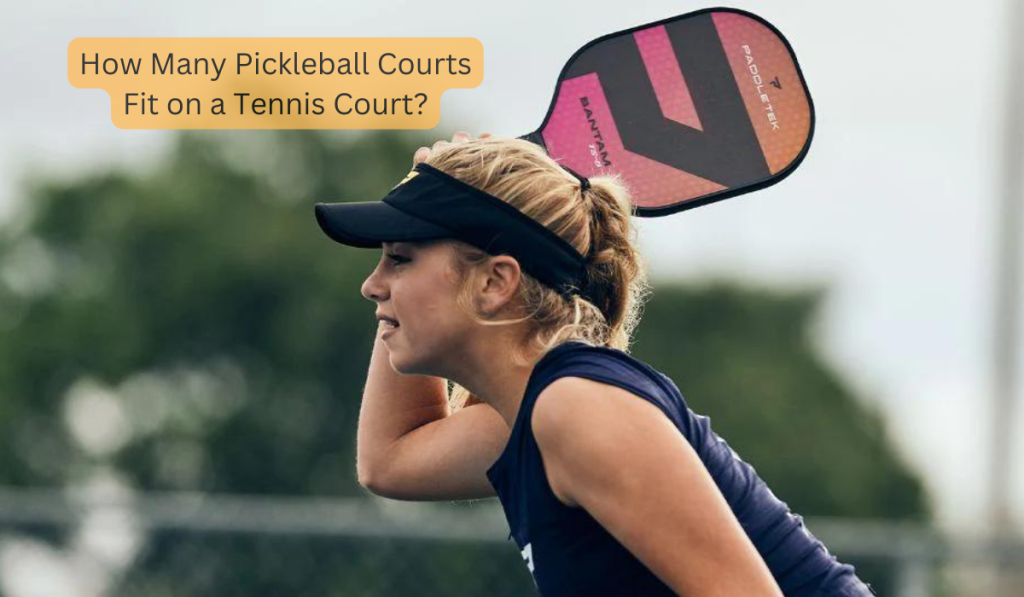
Pickleball is a fast-growing sport that has been gaining popularity across all age groups in recent years. Originating in the 1960s, pickleball combines elements of tennis, badminton, and ping pong. The smaller court size, paddle, and plastic ball allow pickleball to be an accessible and fun game for people of all athletic abilities. As the sport continues to grow exponentially in the United States and globally, many tennis facilities and clubs are looking to convert some of their tennis courts to accommodate pickleball. But How Many Pickleball Courts Fit on a Tennis Court?? Here is a breakdown of the most common pickleball court configurations on a tennis court:
4 pickleball courts on a tennis court
The most common configuration is to fit 4 pickleball courts on one standard-sized tennis court. Tennis courts are generally 78 feet long by 36 feet wide, giving a total area of 2,808 square feet. A regulation pickleball court is 44 feet long by 20 feet wide, totaling 880 square feet. With 4 pickleball courts lined on a tennis court, sufficient space remains for safety runoff space between courts and along the borders. This allows 2 doubles pickleball games to occur simultaneously.
Converting a tennis court to four pickleball courts involves taping temporary pickleball court lines onto the tennis court surface. Taping provides a reversible and temporary conversion method, with minimal costs compared to permanently painting new lines. The tape may also keep the tennis court lines visible underneath. Players can set up portable pickleball nets for play when needed and take them down for storage.
Some facilities opt to paint 2 pickleball courts on each side of a tennis court instead. While this takes up more of the tennis court space, it provides a more permanent pickleball court setup. The cost to convert a tennis court to dedicated pickleball courts through painting lines is higher than using temporary tape, but creates a multi-use court for both tennis and pickleball. Temporary pickleball lines on a tennis court with tape allows switching back and forth between sports more easily.
2 pickleball courts on a tennis court
Some tennis facilities choose to fit just 2 pickleball courts on a tennis court. This allows for a larger safety space between the 2 pickleball games. It also provides room for players to stand behind the baselines without interfering with play on the adjacent court.
When using 2 pickleball courts, you must use portable nets. Set up the nets for pickleball during play and then remove them afterward, allowing the space to remain available for tennis. Taping temporary pickleball lines on a tennis court is also an option. An advantage of having just 2 courts is that larger groups of players can use the courts, as they accommodate 4 to 6 players each.
Compared to fitting 4 pickleball courts on a tennis court, having just 2 courts provides more room around each court for players to maneuver and spectators to stand. While 4 courts allow more simultaneous play, the tradeoff is less space around each court. 2 courts is a good compromise that balances maximizing play while retaining adequate safety space.
The cost to convert a tennis court to pickleball depends on the method. Simply taping lines and using portable nets is very affordable. Painting permanent pickleball lines and installing fixed nets has a more upfront expense. But over time, permanent pickleball courts provide better play and easier ongoing use.
Cost to Convert a Tennis Court
The cost to convert a tennis court to a permanent pickleball court ranges from $3,000 to $7,000 on average. The biggest cost is repainting the surface with permanent pickleball court lines if desired. Other costs may include:
- Pickleball nets and net posts – $200-500 each
- Surface preparation and cleaning
- Paint and striping for permanent lines – $1,500-3,000
- Installation of net posts if permanent – $500-1,000
Temporary conversion costs are much lower, from $50 to $500. This includes tape for temporary pickleball lines on the tennis courts and the rental or purchase of portable nets and posts. Court surfacing is not altered.
Many public parks and recreation facilities start by testing community interest with temporary pickleball line taping and portable nets. Once we confirm the demand, we may proceed with permanent conversions.
How many pickleball courts fit on a tennis court? Typically, 4 pickleball courts can fit on one tennis court. The pickleball court size is 20×44 feet, while a tennis court is 78×36 feet. By dividing the tennis court diagonally, you can fit 4 pickleball courts on a tennis court.
Some facilities may opt to only convert half a tennis court, allowing 2 pickleball courts on a tennis court. This leaves the other half open for tennis play. The choice depends on demand and multi-use goals.
The cost of converting a tennis court to pickleball depends on whether it’s a temporary or permanent conversion and the number of pickleball courts added. Permanent conversions run $3,000 to $7,000 on average for a full tennis court.
Conclusion
The most popular configuration is fitting 4 pickleball courts on an existing tennis court. This allows simultaneous doubles play. Affordably testing the conversion before making permanent changes involves taping temporary lines and using portable nets. With pickleball still rising in popularity, converting underutilized tennis courts to multi-use facilities is an effective way to meet community recreation needs.
FAQs
What is the standard size of a tennis court and how does it affect Pickleball court conversion?
The standard size of a tennis court is approximately 78 feet in length and 36 feet in width for singles matches, which can affect the conversion to Pickleball courts, as adjustments need to be made to accommodate the smaller size of Pickleball courts.
Is there a recommended layout for fitting multiple Pickleball courts onto a single tennis court?
Yes, there are recommended layouts for fitting multiple Pickleball courts onto a single tennis court, with variations depending on the available space and the desired number of Pickleball courts.
Can a standard tennis court be easily modified to accommodate multiple Pickleball courts?
Yes, a standard tennis court can be modified to accommodate multiple Pickleball courts with proper planning, measurements, and adjustments in the court layout.
Key considerations include accurately measuring the dimensions of the tennis court, ensuring adequate space between Pickleball courts, and adjusting the court lines to meet the specifications of the Pickleball court.
While there might not be specific official guidelines for conversion, it is essential to adhere to the regulations set by Pickleball organizations and ensure that the converted courts meet the necessary standards for Pickleball play.
Common challenges include maintaining appropriate court dimensions, adjusting the net height, and ensuring that the court lines are correctly marked for Pickleball play.
Pickleball courts are notably smaller than standard tennis courts, so the conversion process involves resizing the court, adjusting the net positions, and ensuring that the court lines meet the specific requirements of Pickleball gameplay.

Pingback: Playing Pickleball on a Tennis Court